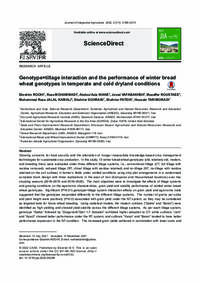Genotype×tillage interaction and the performance of winter bread wheat genotypes in temperate and cold dryland conditions

Authors:
Growing concerns for food security and the alleviation of hunger necessitate knowledge-based crop management technologies for sustainable crop production. In this study, 13 winter bread wheat genotypes (old, relatively old, modern, and breeding lines) were evaluated under three different tillage systems, i.e., conventional tillage (CT, full tillage with residue removed), reduced tillage (RT, chisel tillage with residue retained) and no-tillage (NT, no-tillage with residue retained on the soil surface) in farmer’s fields under rainfed conditions using strip-plot arrangements in a randomized complete block design with three replications in the west of Iran (Kamyaran and Hosseinabad locations) over two cropping seasons (2018–2019 and 2019–2020). The main objectives were to investigate the effects of tillage systems and growing conditions on the agronomic characteristics, grain yield and stability performance of rainfed winter bread wheat genotypes. Significant (P<0.01) genotype×tillage system interaction effects on grain yield and agronomic traits suggested that the genotypes responded differently to the different tillage systems. The number of grains per spike and plant height were positively (P<0.0) associated with grain yield under the NT system, so they may be considered as targeted traits for future wheat breeding. Using statistical models, the modern cultivars (“Sadra” and “Baran”) were identified as high yielding and showed yield stability across the different tillage systems. As per each tillage system, genotype “Sadra” followed by “Zargana-6//Dari 1-7 Sabalan” exhibited higher adaption to CT; while cultivars “Jam” and “Azar2” showed better performance under the RT system; and cultivars “Varan” and “Baran” tended to have better performance expression in the NT condition. The increased grain yields achieved in combination with lower costs and greater profits from conservation agriculture suggest that adapted cultivar and NT systems should be evaluated and promoted more widely to farmers in the west of Iran as an attractive package of crop management technologies. In conclusion, variations in the performance of genotypes and the significant genotype×tillage system interaction effects on grain yield and some agronomic traits assessed in this study suggest that the development and selection of cultivars adapted to the NT system should be considered and included in the strategies and objectives of winter wheat breeding programs for the temperate and cold dryland conditions of Iran.
